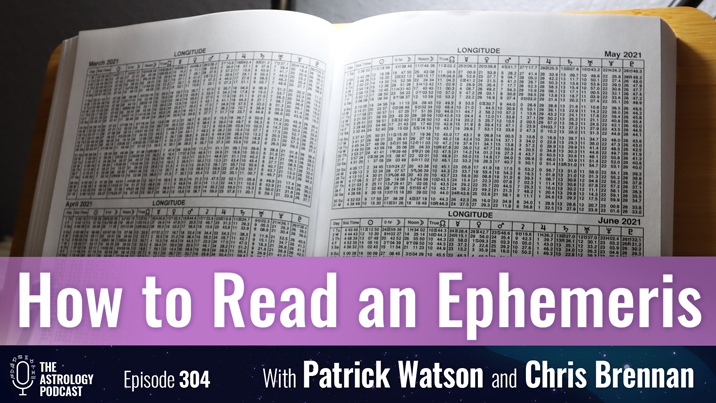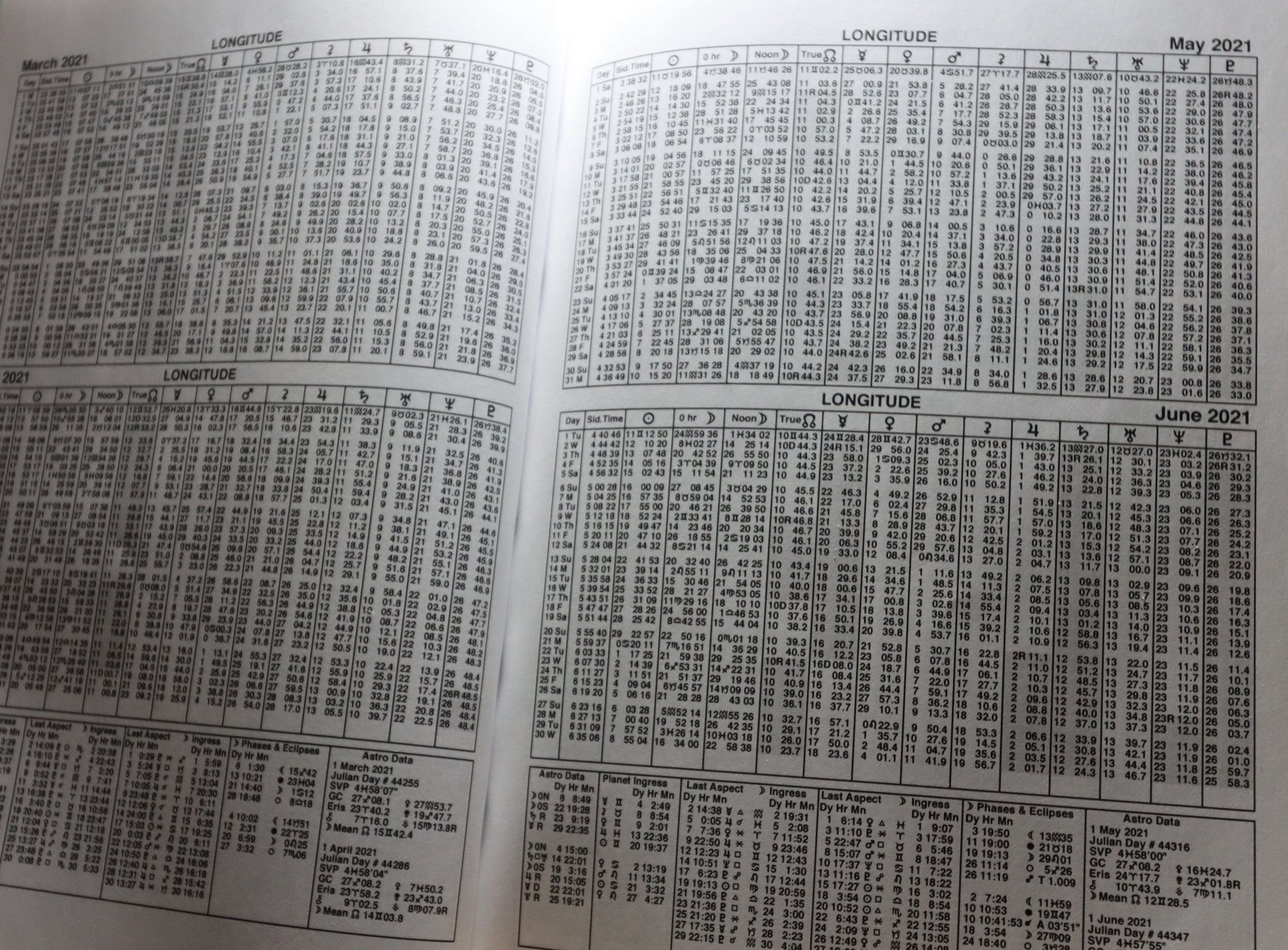
In episode 304 astrologer Patrick Watson joins the show to talk about how to use an ephemeris to study the movements of the planets in astrology.
An ephemeris is a book of planetary positions that lists where the planets will be in the zodiac in the past, present, or future.
In the past it was used by astrologers in order to calculate birth charts by hand, but these days it is mainly useful for studying planetary transits and cycles.
During the course of the episode we give a detailed introduction to the ephemeris, talk about some of the things you can do with it, and how to use it to improve your technical skills as an astrologer.
For more information about Patrick check out his website:
This episode is available in both audio and video versions below.
Ephemeris Episode Outline and Show Notes
Here is an outline of some of the main points discussed in the episode:
- Definition: what is an ephemeris?
- Definition from Google/Oxford Languages:
- “a table or data file giving the calculated positions of a celestial object at regular intervals throughout a period.”
- “a book or set of such tables or files.”
- An ephemeris is just a listing of planetary positions.
- A handy way of tabulating the data.
- Gives you the ability to look at large compilations of data at a glance.
- Pronounced e·phem·er·is
- Ephemeris is the singular, while the plural is ephemerides.
- There are different types of ephemerides
- Astrodienst ephemeris available online for free (Swiss Ephemeris)
- Astro.com > All about astrology > 9000 years ephemeris
- Astro-Seek ephemeris:
- Astro-seek.com > Astro Tools > Ephemeris Tables
- The American Ephemeris is the printed ephemeris we use and recommend
- It is the most common one among US astrologers at this point.
- So we will focus on that and the Astrodienst ephemeris
- There are different varieties of the American ephemeris.
- Primary difference is year ranges
- How the main one to get at this point is the trans-century ephemeris for 1950-2050
- Midnight versus noon ephemeris
- Midnight version starts the day at midnight
- Noon version starts the day at noon
- Difference is negligible for most planets, so either will do.
- I usually use the noon version so that you know where the planets are mid-day
- Prerequisites for using an ephemeris
- Memorizing the glyphs for planets and signs
- Memorizing the aspects ranges between planets
- Understanding planetary movements
- Ephemeris displays longitudinal movements of the planets through signs of the zodiac
- Along the ecliptic, which is the path of the Sun
- Breaking down the info shown on a page of the American Ephemeris
- Month, year, day
- All the planets and their longitudes and whether direct or retro
- Stations, ingresses, last aspect of Moon
- Moon phases and eclipses
- Miscellaneous astro data: asteroids, galactic center, mean node
- Direct versus retrograde motion
- American Ephemeris shades retrograde planets, which is a nice feature
- Seeing how fast or slow different planets move.
- It shows what degree and minute each planet is at at the start of the day
- Unless you use the noon version
- You have to infer based on planetary speed where it is during the day
- For that reason the ephemeris is pretty approximate for planets like the Moon.
- Astrologers used to have to calculate charts by hand based on the ephemeris
- Also needed an atlas for time zone changes
- Table of houses
- These days all computer programs run on a digital ephemeris
- Astrodienst licenses their Swiss Ephemeris for developers
- Astrolabe licenses the ACS Atlas licenses their atlas for developers.
- Book for calculating charts
- Simply Math: A Comprehensive Guide to Easy & Accurate Chart Calculation, Lauran Fowks and Lynn Sellon
- Used to surprise me that astro programs are not real time, but calculate based on ephemerides that were calculated years earlier.
- This is because the planetary movements are so fixed and regular that once you have them down you can project them far into the future or past.
- Planetary cycles
- Ephemeris can help you get a sense for how long to complete a cycle
- E.g. Moon takes a month, Sun takes a year, Jupiter 12, Saturn 27-30.
- There are also broader cycles such as synodic cycles.
- You can use the ephemeris to see movements of planets but also transits to your chart
- Keeping your natal chart in the back of your mind
- Knowing which signs and degrees natal planets occupy
- So when you see a planet at a specific degree you know it’s important for you
- Or someone you know: parent, sibling, partner, pet turtle, etc.
- Can use books like Planets in Transit to look up transit meaning
- Benefit of knowing planetary cycles is that you can gauge how common a transit is.
- It also allows you to recognize connections between time periods that can give you insight into the themes and qualities of future events.
- You can do secondary progressions with an ephemeris for the year you were born
- Other types of ephemeris or specialized ephemerides
- Astrodienst’s Planetary Cycle Data
- Astro.com > All About Astrology > 9000 Years Ephemeris > Planetary Cycles and Sign Ingresses
- Provides precise dates/times of heliacal risings and settings for each planet instead of the traditional 15 degree rule
- Also provides dates of maximum elongation for Mercury and Venus, not always easy to spot by eye
- Declination/Latitude Ephemeris
- Astro.com > All About Astrology > 9000 Years Ephemeris > 21st Century > with declination and latitude
- Also available on Astro-seek.com
- Aspect Ephemeris
- Asteroid Ephemeris
- Midpoint ephemeris
- Hypothetical Planets Ephemeris
- Astrodienst’s Planetary Cycle Data
- Tables of Planetary Phenomena, Third ed. Michaelsen and Pottenger
- Has a great eclipse ephemeris
- I created a similar eclipse ephemeris for our eclipses episode.
- Outer planet ingresses
- Outer planet conjunctions, etc.
- Has a great eclipse ephemeris
- You can use software programs these days to generate lists like this.
- The animate chart feature kind of serves the same function
- But it is different having it all laid out in front of you
- The ability to flip forward to months or years easily
Watch the Video Version of This Episode
Here is the video version of this episode on how to read an ephemeris:
–
Transcript
A full transcript of this episode is available: Episode 304 transcript
Listen to the Audio Version of This Episode
You can either play the audio version of this episode of the podcast directly from the website or download it as an MP3 to your device by using the buttons below:
Podcast: Play in new window | Download (Duration: 2:23:09 — 131.4MB)
